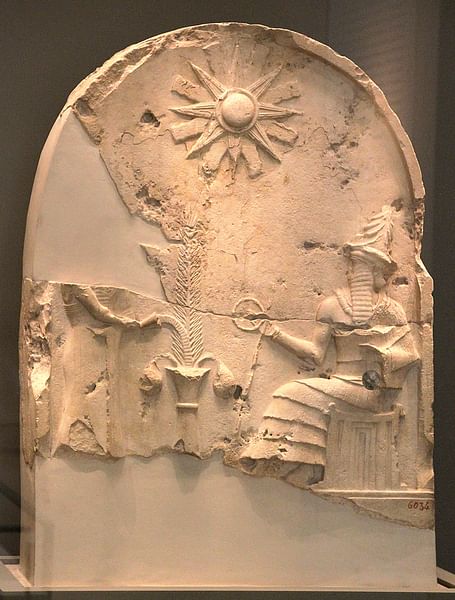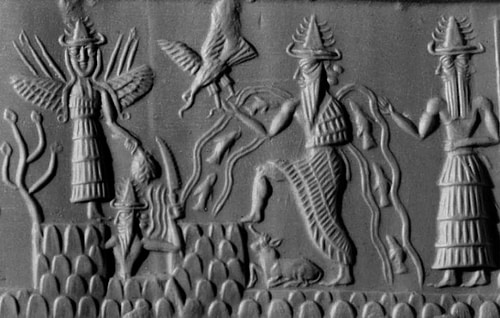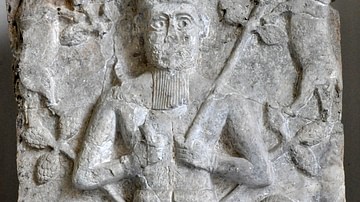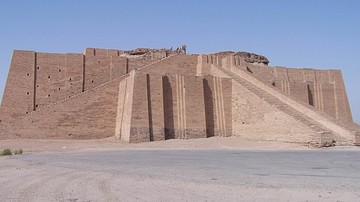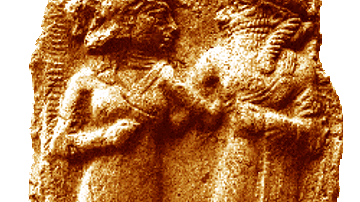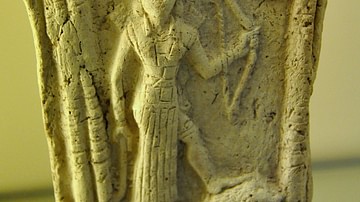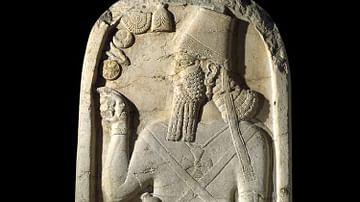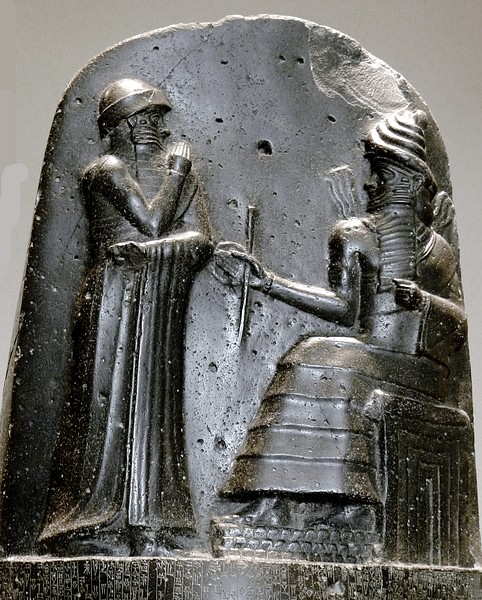
Utu (also known as Shamash, Samas, and Babbar) is the Sumerian god of the sun and divine justice. He is the son of the moon god Nanna and the fertility goddess Ningal in the Sumerian tradition but was known as Shamash (Samas) to the Akkadians who claimed Anu or Enlil as his father.
In the Sumerian tradition, he is the twin brother of Inanna (goddess of war, love, and sexuality) and brother of Ereshkigal (Queen of the Dead), and Ishkur (also known as Adad, god of storms). He is one of the most important deities in the Mesopotamian pantheon and is attested to in the earliest Sumerian writings c. 3500 BCE, though seemingly after the appearance of Nanna.
He is usually depicted as an old man with a long beard whose shoulders emanate rays of light but is also represented as the solar disc or, in the Neo-Assyrian Period (c. 912-612 BCE), as a disc with wings. The famous law code of Hammurabi (1792-1750 BCE) addresses Shamash by name and claims it was he who provided humanity with law. In Sumer, his cult centers were at Larsa and Eridu and to the north, in Akkad, he was famously venerated at Sippar. His temples were known as E-babbar ('White House' or 'Shining House') which name attached itself to the god as Babbar, the illuminating one.
Utu/Shamash's wife was Serida (in Akkadian, Aya), the goddess of the dawn who, by the Old Babylonian Period (c. 2000-1600 BCE), was the patroness of the naditu. These were cloistered women who had dedicated themselves to the divine, similar in some ways to certain orders of Catholic nuns in the European Middle Ages and the present day. The naditu are routinely associated with Utu/Shamash because their cloister was attached to his temples, but they actually worshiped and served his wife Serida/Aya.
The first literary hymns addressed to this god by the name Shamash (Samas) date from c. 2600 BCE, but he was referenced as Utu or Shamash regularly throughout Mesopotamian history from the advent of cuneiform writing (c. 3500 BCE) until its abandonment c. 100 BCE, well over three thousand years. His symbol of the solar disc shows a circle with four points protruding toward the cardinal directions and four wavy lines emanating diagonally outward from between them, representing the power, light, warmth, and reach of the sun.
God of Justice
As the sun sailing across the sky could obviously see everything that transpired on earth, Utu/Shamash was not only the bringer of light but the arbiter of justice. Scholar Jeremy Black notes how Utu/Shamash "represents the brilliant light of the sun which returns every day to illuminate the life of mankind, as well as giving beneficial warmth which causes plants to grow" (182). The light of the sun was thought to be able to penetrate and pierce every level of the earth, even to the underworld, and illuminate the human heart. There was nothing, therefore, which Utu/Shamash did not see. Scholar E. A. Wallis Budge notes:
In primitive times he was supposed to stride over the heavens on foot but in later times to do so in a fiery chariot which was drawn by animals driven by one Bunene. He was regarded as a gracious god for he helped all who were in trouble, gave life to the dead, and set free him that was in bonds. Possessing the power to see everywhere, he knew all things, and judged men rightly. (85)
Bunene, a minor deity, is often represented as his son and was worshiped at Sippar, Uruk, and Ashur as a god of justice. As the son of Nanna, Utu/Shamash was always listed in a secondary position to his father, but he was by no means considered of any less importance. His symbols and signs, as well as myths and hymns, are among the most numerous in Mesopotamian artifacts, inscriptions, and literature.
Hammurabi, a very clever and careful king, understood well how invoking the name of Shamash for his law code would give it considerably more weight. This is not to say he did not believe in this god or his power, but he could have as easily chosen Marduk (who was, after all, patron god of his city of Babylon) or Enki, well known as the god of wisdom. Utu/Shamash was the clear choice, however, because his presence was so obvious daily through the light of the sun.
God of the Sun
Every morning Utu/Shamash emerged from the doors of heaven in the east. Two lesser gods swung wide these doors for him as came forth and stepped into his chariot to ride across the sky toward the west, where two other gods opened their gates for him to enter. He then rested in the underworld until he was awakened by his wife at dawn and went again to his chariot. The entrance to the Mesopotamian underworld was thought to lie in the west, quite close to the western gates of the sun god, and in some eras, it was believed that Utu/Shamash descended into the underworld at dusk to judge the dead.
The judgment of the dead is an interesting variation on the standard view of the underworld in which the souls of the departed were all equal. Death was the great equalizer that brought king and beggar to the same exact place; there was no demarcation of a heaven or hell but only a dim realm where the souls ate of the dust and drank from muddy puddles. In the Sumerian belief, however, the dead were judged and that judgment affected their future in the afterlife, even if by very little. Orientalist Samuel Noah Kramer writes:
The deceased were not treated all alike; there was a judgment of the dead by the sun god, Utu, and to a certain extent by the moon-god Nanna, and if the judgment was favorable the dead man's soul would presumably live in happiness and contentment and have all it desired. However, the indications are that the Sumerians had but little trust in hopes of a blissful life in the nether world even for the good and deserving. By and large the Sumerians were convinced that life in the nether world was but a dismal, wretched, reflection of life on earth. (135)
Still, since the sun could illuminate even the darkest places, it seems there was hope that Utu/Shamash would reach into the netherworld and touch the souls of the departed. Like his father Nanna, Utu/Shamash then served as a kind of bridge between the living and those who had passed on to the other side. It was believed that food and water and other offerings should continue to be brought to the dead because they continued to exist, simply without bodies, and so needed sustenance.
However Utu/Shamash's judgment of them went, it was clear the souls still existed to be judged, and so the living continued to honor them with offerings. If the dead were worthy of notice by the sun god, mortals could take the time to honor and remember them as well. Utu/Shamash is almost always depicted as a kind benefactor, freely giving the gifts of life, but like many of the most important Mesopotamian gods, he was a completely realized individual and was not above refusing a request which inconvenienced him.
Utu/Shamash in Myth
Most of the myths featuring Utu/Shamash emphasize his kindness and generosity. In the Myth of Etana (which predates the reign of Sargon of Akkad, 2334-2279 BCE), the hero petitions Shamash for aid in helping his wife conceive at the same time that an eagle and a serpent are feuding over ownership of a poplar tree and are also asking for help. The god takes care of each request justly and carefully in the same way as, in The Epic of Gilgamesh, he helps the hero conquer the demon of the Cedar Forest, Humbaba. He was not always so accommodating, however.
In the story of Inanna and Huluppu-Tree, the goddess takes a young Huluppu-tree (possibly a willow) and transplants it in her city of Uruk, thinking that, when the tree reached maturity, she would use its wood to craft a throne and couch to recline on. As the years went by, a snake built a nest in its roots, an Indugud-bird nested in its branches and, at its center, the evil spirit of a Lillitu set up house. When Inanna came to water her tree one evening and found these unwanted guests, she sat down and cried through the night.
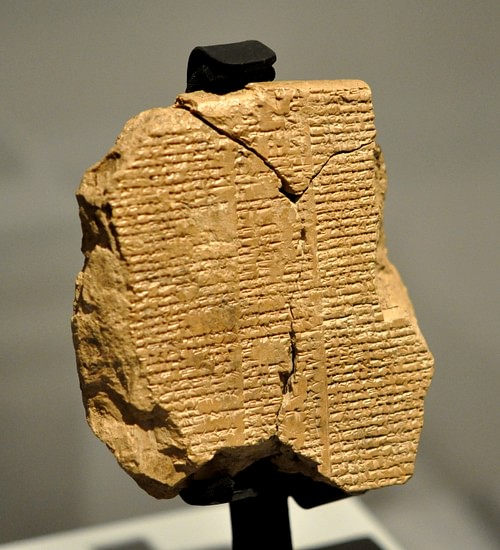
At dawn, her twin brother Utu/Shamash rose in the east and began his journey across the sky. Inanna called out to him and told him of her trouble, but he could not stop his daily trek and, further, told her he felt no need to. Inanna then sought the aid of Gilgamesh, who killed the snake, drove the bird away, and sent the Lillitu demon running. Afterwards, he cut down the tree and presented it to Inanna for her throne and couch.
This same story is told, in part, in Gilgamesh, Enkidu, and the Netherworld and Inanna's plea is understood as no selfish request on her part because, from the tree, she created the magical items thought to be a sacred drum and drumsticks for Gilgamesh which he was supposed to use for good but then misused for war; they were taken from him and drawn down to the netherworld. This then sets the stage for Enkidu, the comrade in arms of Gilgamesh and his best friend, to volunteer to descend to the underworld to bring them back and, after he is trapped there, Utu/Shamash parts the veil so that he can return or, in some interpretations, so the two friends can talk one last time.
This myth highlights a central aspect of the personality of Utu/Shamash: his involvement in the most intimate aspects of one's life. Jeremy Black comments on this, after listing the god's aspects regarding the sun and justice, writing:
A third aspect of Utu was his direct interest in the affairs of mankind. one of the early legendary kings of Uruk is described as a 'son of Utu' in the composition called the 'Sumerian King List,' and Utu acted as a special protector of some of the later heroic kigs of the city, for instance Gilgamesh. In the Babylonian Epic of Gilgamesh, Shamash helps the hero against the monstrous guardian of the Cedar Forest, Humbaba. In the Sumerian poem 'Dumuzi's Dream,' Utu helps Dumuzi to escape from the galla-demons who have come to take him to the underworld. (184)
Throughout The Epic of Gilgamesh, Utu/Shamash is noted for his kindness and diligence in watching over the hero and, for this reason, came to be regarded as the patron god of travelers and vagabonds. He also became associated with the highest of the gods and even the benefactor of the gods, who provided them with a home.
At one point in The Epic of Gilgamesh, when Gilgamesh and Enkidu are setting out for the Cedar Forest, Gilgamesh says to his comrade, "Where is the man who can clamber to heaven? Only the gods live forever with glorious Shamash, but as for us men, our days are numbered, our occupations are a breath of wind" (Sanders, 71). The hopes and dreams, the aspirations and struggles of humanity were considered little more than a vapor, but Utu/Shamash was eternal, and he would continue on long after any individual life was only a memory. Although his name was forgotten as Christianity gained acceptance, the vision of a loving son of a god, the light of the world, was not.
